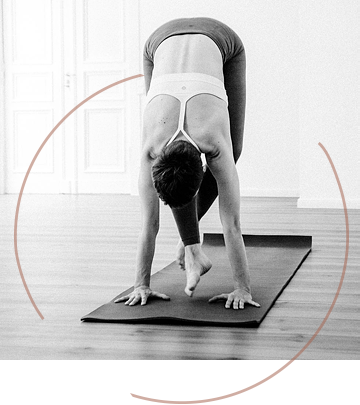Beginner
We always need to start somewhere
No matter where you are in your process: where you are is a good starting point.
And yes, it is difficult to not just think or talk about beginning a regular yoga practice, but to actually begin.
Yes, it takes courage and determination.
Yes, you will convince yourself to definitely start tomorrow — but only to realize that you need two or three more loops until you are really and truly ready.
And yes, you will find innumerable reasons to stay in bed tomorrow morning.
Yes.
But.
It is worth it.
And please remember: You do not need to know. Oftentimes, people come to their first Mysore Style practice, apologizing for not knowing the Ashtanga sequence yet and for being a beginner. Forget about that. You don’t have to have done any other yoga before, in order to start with Ashtanga. It is not a shame to be a beginner, it is an opportunity.


Ashtanga Mysore Style is different
If you have previous yoga experience, you will instantly notice that a Mysore Style class is somehow different. Guidance from the teacher happens in a different way. Unlike to ‘normal’ yoga classes, there will be moments, where you won’t have a clue about what to do next. That’s ok. Just wait. Or ask. Or try. Or repeat what you already know. There’s no need for pleasing anyone and perfection is an illusion anyway.

Acknowledging where you are in your relationship with yoga, we’ll start the process simple and basic, allowing enough time for repetition, mistakes and questions. We’ll build up your practice incrementally, respecting your own pace and making sure that one bit of practice is digested before adding the next.
Repetition is the key
When you begin a Mysore Style practice, you’ll notice that there is quite a lot of input and memorizing of breath-movement patterns involved. Repetition is the key. The more time you allow for repetition, the easier and quicker the breath-movement patterns (asana / vinyasa) will seep into your system. The quicker you’ll feel the rewards, the flow, the meditative and grounding aspects of this beautiful practice. Hence, it is advisable to come to class at least twice a week.
This form of practice and teaching can be revealing and at times confrontational. Often, this is a sign that transformation is taking place in the physical and most probably also in the mental and emotional sphere. You also might encounter moments of frustration and a longing for smoothness. That is part of the process. Friction is a necessary aspect of transformation.
See you soon.
PS: If you want to get a feeling for the space and meet me in person before you decide to pick up a regular practice at the Shala, please feel free to contact me and we will schedule an appointment:
konstanze@ashtangashala-berlin.de
